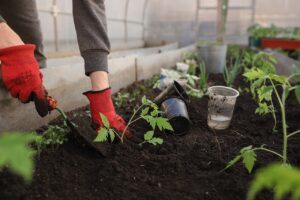
Creating a Healthy Ecosystem – Garden Designs (Easy tips for new gardeners/ or ones looking for ideas)
Your garden is more than just a place for plants. It’s a mini-world where different living things, like birds, bees, and plants, live together. Therefore, as you design your garden, consider how it can support all these different lives.
In this article, you’ll find easy and practical tips to make your garden a better home for nature. Whether new to gardening or looking for new ideas, you’ll learn how to choose plants, create homes for wildlife, and use smart gardening practices. Let’s get started!
The Principles of Ecosystem Gardening
In ecosystem gardening, the goal is to create a healthy, balanced garden. It means encouraging different plants and animals to live together in harmony.
First, diversity is key. A diverse garden attracts various insects and birds, which helps to maintain a natural balance. It also requires different plant species.
Next, natural pest control is an important aspect. This approach uses nature to keep harmful insects away. For example, certain plants and garden creatures like ladybugs and birds are great at controlling pests, so you don’t need chemicals.
Finally, creating habitats in your garden is about providing homes for wildlife like birds and bees. These animals are essential for pollinating plants and maintaining a healthy ecosystem.
These are the principles we’ll focus on in the tips below.
Plan Your Garden Layout for Diversity
When planning your garden layout to enhance its ecological benefits, divide it into different zones. Each zone can have a specific purpose and support different types of plants and wildlife. Start by observing your garden to understand where the sun shines the most and where it’s mostly shady. It will help you decide where to plant sun-loving vegetables and where a cool, shaded woodland area might thrive.
In addition, consider the type of soil in each area and how well it holds water. While some plants prefer dry conditions, others need more moisture. Use this knowledge to place plants in the most suitable zones.
Also, including native plants in your garden is a great way to support local wildlife. They are already adapted to your local climate and soil, making them easier to care for. Plus, they provide familiar food and shelter for local birds and insects.
Maintain Your Garden and Make Seasonal Adjustments
Simple practices like weeding, pruning, and pest control can significantly impact your garden’s well-being. For instance, you can nourish the soil to cope with pests and diseases and increase its worm and microbial activity using Soil Booster.
It’s also important to adjust your garden care with the changing seasons. For example, prepare your garden beds in spring by adding compost and mulch to nourish the soil and plants. Spring is also a great time to plant new flowers and vegetables.
As summer arrives, consider the best watering method for different plants, especially during hot and dry periods, and continue monitoring for pests and diseases.
In autumn, it’s time to plant bulbs for spring and clear any fallen leaves. This season is ideal for dividing perennials and planting new trees or shrubs. Lastly, winter is for planning and preparing for the next growing season. You can also repair garden tools and structures.
Incorporate Wildlife Habitats
Design specific areas tailored to the needs of different wildlife species. For instance, setting up bird feeders in visible areas of your garden provides food for birds and offers you the joy of birdwatching. You can complement these feeders with native plants that produce berries and seeds, which serve as natural food sources.
Creating a butterfly garden is another effective way to support wildlife. Choose nectar-rich flowers that bloom at different times to provide a continuous food source for butterflies. In addition, remember to include some caterpillar host plants where butterflies can lay their eggs.
Bee habitats are also crucial. Bees need flowers for nectar and pollen, so planting a range of flowering plants is essential. Consider adding a bee hotel, a structure with small tubes where solitary bees can nest.
Your garden should also have a simple birdbath or a small pond, making it a more inviting and supportive environment for diverse species.
Use Sustainable Gardening Practices
These practices play a vital role in maintaining a healthy garden ecosystem. For example, composting is a fantastic way to recycle your kitchen and garden waste into rich soil for your plants. It provides your garden with natural, chemical-free nourishment.
Rainwater harvesting is another sustainable practice. You can use it for irrigation, especially during dry spells.
When it comes to fertilization, using organic methods is key. Natural fertilizers like compost or manure are better for plants and the soil. For example, you can use Super Compost to increase soil wettability with its high-quality raw ingredients.
Final Thoughts
Embracing the principles of ecosystem gardening transforms your outdoor space into more than just a collection of plants. It becomes a lively hub of natural activity and beauty, a small but significant contribution to the health of our planet. You also benefit from such a change.
For instance, adding feeders and wildlife food sources invites birds and other animals into your space. As such, you enjoy hobbies like bird watching without leaving your backyard. On top of that, you can plant fruits and vegetables that are food sources for your household.